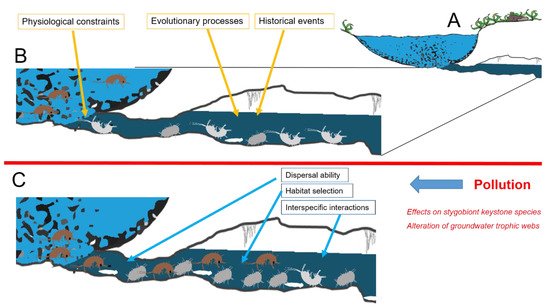Several metals and contaminants were reported to cause mortality in a number of stygobiont species that do not necessarily occupy key positions in the groundwater trophic web [
32]. The effects of such contaminants can vary according to the duration and the intensity of the pollution events. In the case of chronical events with extensive releases of toxic contaminants, the effects on the groundwater trophic webs are likely to resemble those observed in epigean freshwaters, where strongly unbalanced communities are characterized by a few dominant, tolerant species, usually detritivores [
58,
59]. Unfortunately, despite several anecdotal reports of subterranean rivers and streams being chronically or occasionally polluted by heavy metals and xenobiotic compounds, no studies detail the features of their stygofauna; as an example, hearsay affirms that, because of chemical pollution, the stygofauna of one of the most important Italian subterranean rivers, the Timavo, was extremely impoverished during the 19th century, with the disappearance of both top predators such as the olm and typical detrtivore species such as the shrimps of the genus
Troglocaris. Studies depicting such effects and providing management perspectives in terms of recovery of the stygofauna communities can be particularly important, especially for the karst areas occurring in emerging countries where pollution effects can be overlooked by current policies.
Something much more challenging is addressing the effects of organic pollution. In temperate regions, groundwaters are usually oligotrophic environments, especially if compared to the surface water bodies [
60]. When organic pollution occurs, major changes in the trophic web structure are likely [
61]. The first strong effect is on biofilms, which strongly increases their shape and biomass [
62]. Thus, signs of organic enrichment in subterranean streams and pools can be easily detected when the sites are accessible [
56]. Both organic compounds and biofilms may constitute a resource for stygobionts but may also be detrimental. Indeed, in a review of the few studies documenting the effects of organic pollution on cave macrobenthos, Wood et al. [
63] showed that responses at the community level may be quite variable. Particularly, not only reductions in abundance or local extinctions of stygobionts were reported but also cases of increase in the abundance of certain species and trophic groups. Among taxa that could be favored by nutrient enrichment, there are stygobiont isopods. They usually occupy the role of primary consumers and feed on decaying organic material [
64] and biofilms [
61]. Different past studies evidenced high abundances of isopods in polluted subterranean streams. For example, Holsinger [
65], in a cave polluted by sewage, observed in the same sampling occasions both the stygobiont isopod
Caecidotea recurvata and its predator
Phagocata subterranea. Maximum density of isopods was particularly high (60.9 individuals/m
2) compared to that that of planarians (25 individuals/m
2) [
65]. More than 30 years after, a study performed on the same site that considered only crustaceans revealed that the maximum density of
C. recurvata was even higher in moderately and slightly polluted pools (74.6 individuals/m
2), while the stygobiont
C. recurvata was only present in unpolluted water bodies of the cave [
66]. Even though there is no information on the situation prior to pollution, organic enrichment seems to have privileged only one species of primary consumer that became dominant. Moreover, the main predator of this primary consumer was apparently favored, while its predator other species with different tolerance and possibly trophic niches disappeared [
63,
66]. A similar situation with dearth of amphipods and richness of isopods following organic pollution was recorded by Graening and Brown [
29]. In that case, the alteration of the groundwater trophic web apparently provided advantage to a cavefish predator,
Amblyopsis rosae, and diminished the occurrence of a salamander predator,
Typhlotriton spelaeus [
29].
A natural way of organic enrichment for groundwaters is represented by bat guano that may strongly affect groundwater’s community structure [
63]. Bat guano not only may supply sufficient resources to decrease the selective pressure posed by oligotrophy, but when it is particularly abundant, it may also generate situations similar to anthropogenic organic inputs for stygofauna. A case of natural organic input suggested to be detrimental is represented by
Paradactylodon gorganensis, a salamander that is considered as a valid species as an ecotype of
Paradactylodon persicus.
P. gorganensis breeds in the terminal trait of an Iranian subterranean stream, which seems polluted by the guano of the bat
Myotis blythii [
67], posing questions of whether to limit bat occurrence in that site. In this case, further studies are necessary to assess if the organic enrichment could be a threat or, instead, provides resources for the prey of the salamanders.
Moreover, as guano abundance reflects bats’ populations trends, it may be a variable resource. Currently, bat populations are declining, and this decline may be detrimental also for groundwaters communities that rely on guano for their survival [
68]. Assessing how bat populations trends result in changes in groundwaters’ community structure could be a promising field of research as the hypothesis that minor organic enrichment/pollution may be advantageous to stygofauna under some circumstances [
45].

